Overview
The Journal of Autism and Developmental Disorders plays a vital role in autism research, offering a compassionate platform for high-quality, peer-reviewed studies. These studies not only enhance our understanding of autism spectrum disorders (ASD) but also inform effective treatment practices that can make a real difference in the lives of individuals and families affected by autism.
This journal fosters collaboration among researchers, clinicians, and educators, creating a community that is dedicated to addressing the challenges faced by those with ASD. It also tracks the rising prevalence of autism and explores the social determinants that influence access to care. By doing so, it helps shape research trends that can lead to improved outcomes for individuals with ASD and their families.
As we navigate this complex landscape together, it’s important to stay informed and engaged. We invite you to explore the valuable insights and resources provided by this journal, and to share your experiences and thoughts as we work towards a brighter future for all affected by autism.
Introduction
In the ever-evolving field of autism research, the Journal of Autism and Developmental Disorders shines brightly as a source of knowledge and innovation. This vital platform not only chronicles groundbreaking studies but also nurtures collaboration among researchers, clinicians, and educators, fostering a community dedicated to understanding autism. With a focus on diverse topics—from diagnostic criteria to intervention strategies—the journal plays a crucial role in shaping best practices and enhancing our collective understanding of autism spectrum disorders.
As the prevalence of autism continues to rise, the journal’s unwavering commitment to high-quality research ensures that its contributions remain both relevant and impactful. It guides the future of autism research, ultimately working to enhance the lives of individuals on the spectrum and their families. Together, let us embrace this journey of discovery and support, as we strive to make a meaningful difference in the world of autism.
The Role of the Journal of Autism and Developmental Disorders in Advancing Autism Research
The Journal of Autism and Developmental Disorders stands as a vital resource in the realm of developmental research, dedicated to sharing the latest findings and insights. Established to offer a comprehensive overview of spectrum disorders (ASD), this journal publishes peer-reviewed articles that explore a variety of topics, from diagnostic criteria to intervention strategies. By fostering collaboration among researchers, clinicians, and educators, it plays a crucial role in enhancing our understanding of autism and guiding effective treatment practices.
Recent statistics reveal a median global prevalence of autism at 65 per 10,000, marking a significant increase from previous estimates. This upward trend highlights the essential role of ongoing research and the Journal of Autism and Developmental Disorders in tracking these changes. Prevalence estimates vary widely, ranging from 1.09 to 436 per 10,000, reflecting the complexity of understanding autism's impact across diverse populations.
Moreover, a review titled 'Social Determinants of Prevalence' sheds light on how factors such as geography and socioeconomic status can influence access to services and diagnosis. It underscores that social determinants interact with biological factors, shaping help-seeking behaviors and access to care. This insight emphasizes the need for targeted policies to address health disparities and ensure equitable access to support.
The Journal of Autism and Developmental Disorders is committed to publishing high-quality studies, ensuring that the findings shared are both trustworthy and applicable in real-world situations. For instance, research published in the Journal of Developmental Disorders has directly influenced treatment methodologies, showcasing the publication's impact on statistics related to developmental conditions and the broader field. As Matthew J. Maenner, a corresponding author at the CDC, remarked, "Findings from the ADDM Network 2020 surveillance year indicate higher ASD prevalence than previous estimates from the ADDM Network and continuing evidence of a marked shift in the demographic composition of children identified with ASD compared with previous years."
As we look toward 2025, the Journal of Autism and Developmental Disorders continues to be an indispensable resource, shaping the landscape of developmental disorders and ultimately supporting individuals with these conditions and their families. We invite you to explore the journal further and join the conversation, as together we can foster understanding and promote positive change.
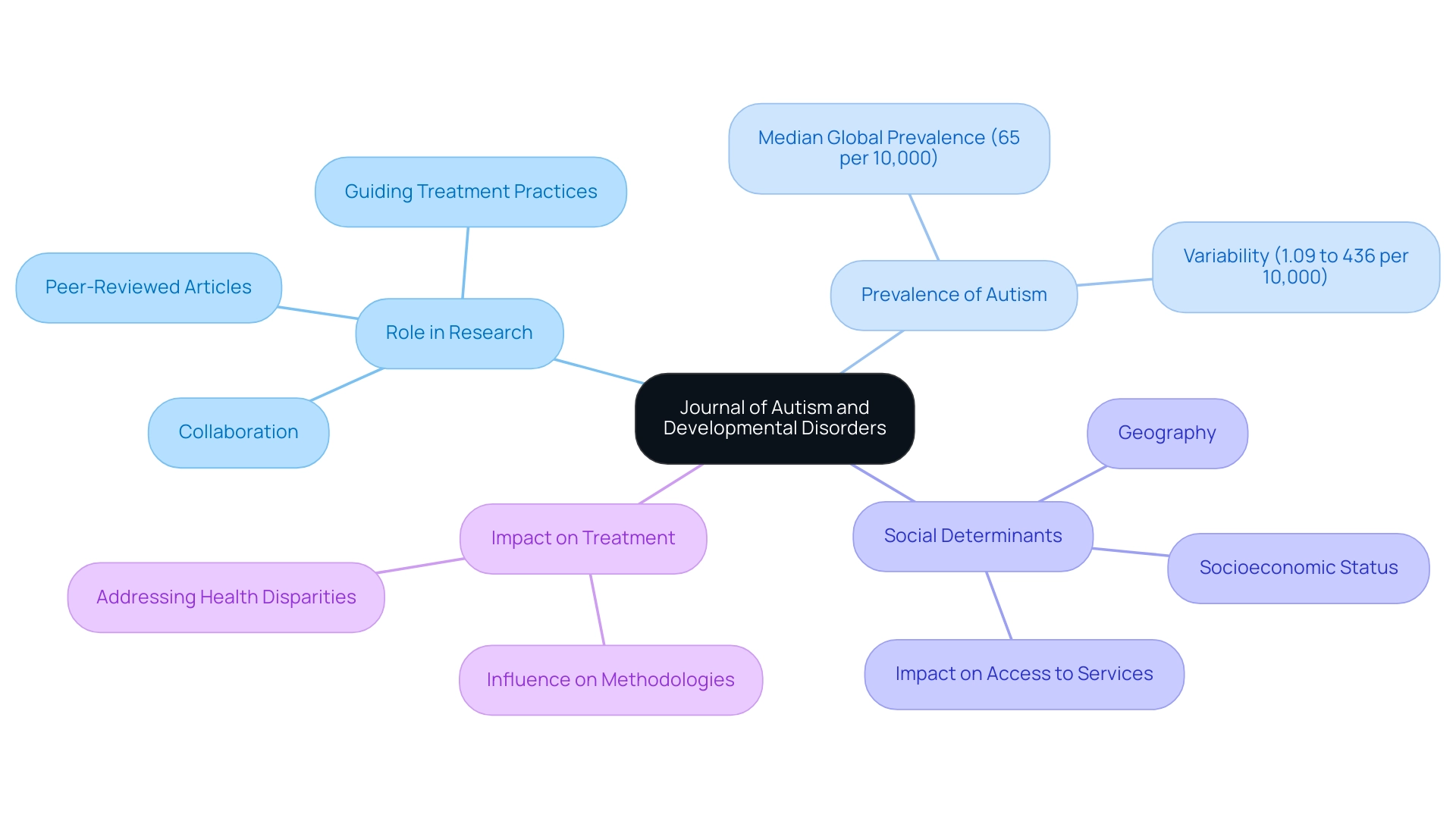
Aims and Scope: What the Journal Covers
The Journal of Autism and Developmental Disorders serves as a crucial platform for a diverse range of topics related to autism, including its etiology, diagnosis, treatment, and educational strategies. By bridging the gap between studies and practice, this publication shares investigations that explore theoretical frameworks and emphasize practical applications in real-world environments. A significant focus on interdisciplinary approaches invites contributions from various fields such as psychology, education, and neuroscience.
This collaborative spirit enriches the journal's content, making it an invaluable resource for academics, practitioners, and families alike. Recent statistics reveal that the prevalence of autism spectrum disorder (ASD) varies significantly across different demographics and identification methods. For instance, in Wisconsin, the prevalence was reported at 28.1 per 1,000 children aged 8 years, highlighting the ongoing need for comprehensive studies and effective intervention strategies. Additionally, a case study analyzing ASD prevalence among children aged 8 years showed an overall rate of 27.6 per 1,000, with variations based on identification types, underscoring the complexities involved in diagnosing ASD.
Notably, girls with ASD are less likely than boys to have information on cognitive ability, pointing to crucial demographic differences that require further investigation. The CDC's Autism and Developmental Disabilities Monitoring Network plays a vital role in providing updated prevalence estimates, emphasizing the importance of continuous study and data collection in understanding ASD. The Journal of Autism and Developmental Disorders features studies that connect theory and practice, showcasing innovative methodologies and findings that can directly inform interventions. As Mayada Elsabbagh noted, 'The considerable progress achieved in increasing awareness and public health response worldwide has gone hand in hand with epidemiological studies offering objective indicators of the impact of this condition, including estimates of cases and their associated social and economic impacts.'
By fostering a cooperative atmosphere, the Journal of Autism and Developmental Disorders serves as an essential resource for enhancing studies related to developmental conditions and improving outcomes for individuals facing such challenges and their families. Together, we can work towards a better understanding and support for those impacted by ASD.
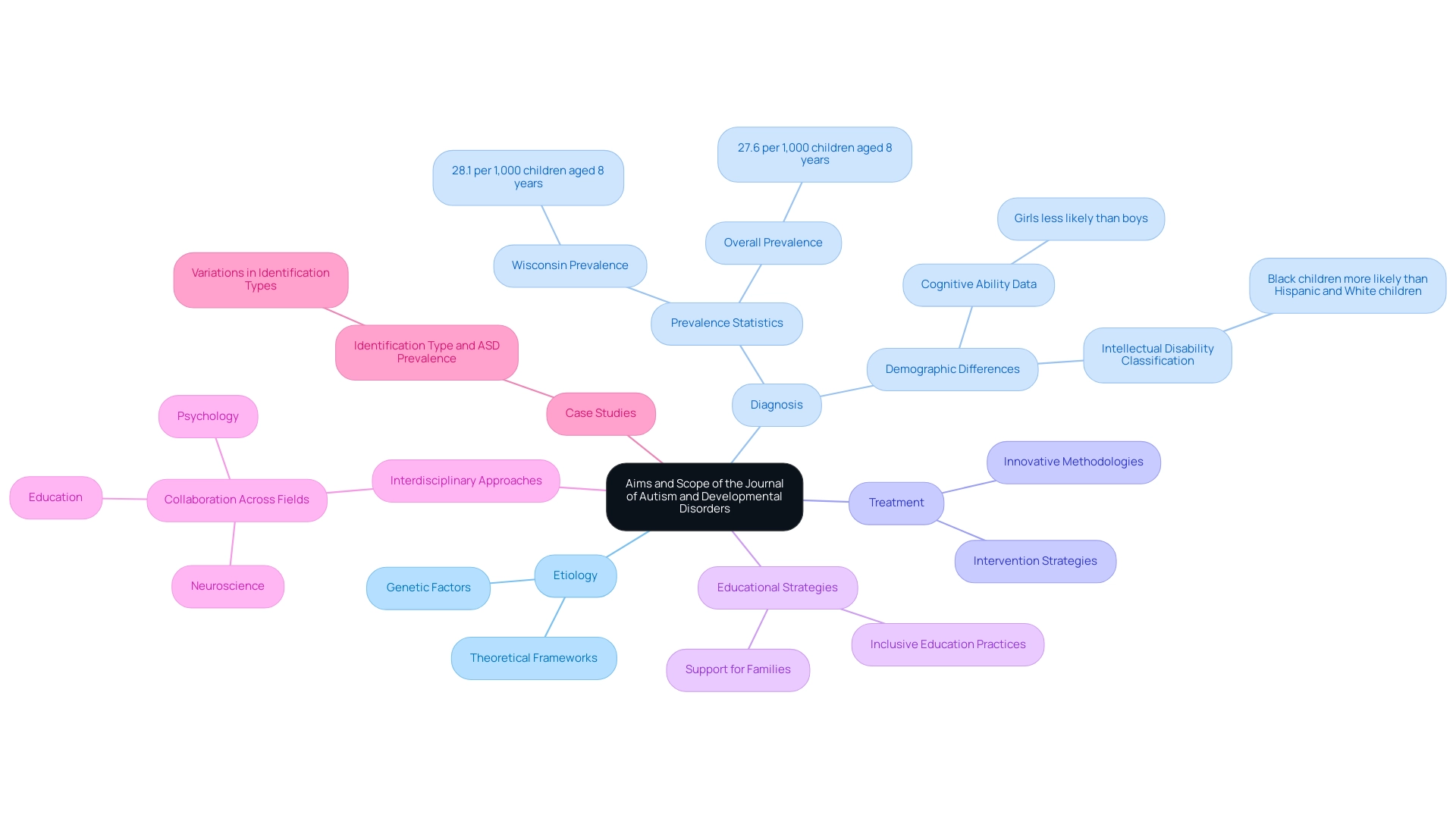
Key Metrics: Evaluating the Journal's Impact and Reach
The Journal of Autism and Developmental Disorders plays a pivotal role in the world of autism research, and its impact is measured through several important metrics, including its impact factor, citation rates, and H-index. As of 2024, this journal has achieved an impressive impact factor of 4.33, underscoring its significant influence in the field. This figure reflects how often articles from this publication are cited in other scholarly works, showcasing its vital role as a trusted source of information for researchers and families alike.
In addition to the impact factor, the H-index serves as a crucial measure of both the productivity and citation effect of its published articles. A higher H-index indicates that many articles have received a notable number of citations, reinforcing the journal's reputation as a leading source in the study of developmental disorders. For instance, it features highly cited papers such as:
- The Autism Diagnostic Interview-Revised, with 7,153 citations
- The Autism Diagnostic Observation Schedule-Generic, with 5,885 citations
- The Autism-Spectrum Quotient (AQ), with 3,837 citations
These influential works are essential in understanding spectrum conditions and provide standardized metrics that can positively impact clinical practices.
Moreover, citation rates for journals focusing on developmental disorders in 2025 continue to reflect the growing interest and importance of this area. The Journal of Autism and Developmental Disorders stands out among its peers, classified as Q1 in the SJR (Scimago Journal Rank) with a SNIP score of 1.86. This classification highlights its commitment to advancing knowledge and fostering collaboration within the developmental disorder research community.
As Fred R. Volkmar insightfully noted, "The Journal of Autism and Developmental Disorders has 1,190 open access articles," which greatly enhances accessibility and impact. This openness enables researchers and practitioners to stay informed about the latest developments in autism studies, ensuring that families receive the support and information they need.
In this ever-evolving field, staying connected to credible resources like this journal can make a significant difference. We encourage you to explore these articles and share your thoughts or experiences in the comments, as your voice is vital in this community.
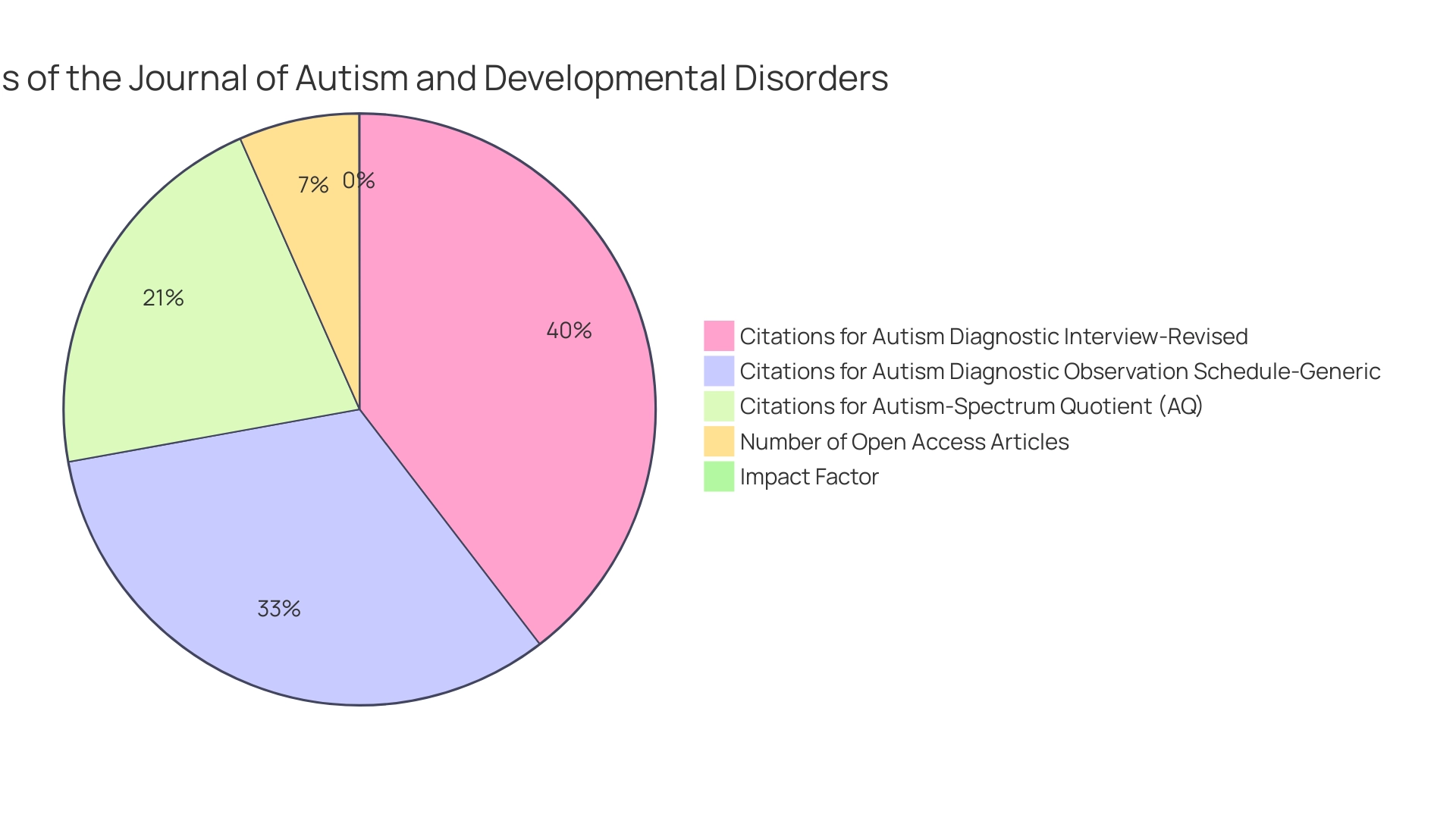
Diversity of Research: Types of Articles and Contributions
The Journal of Neurodevelopmental Disorders serves as an essential platform, offering a diverse array of article types, from empirical studies to theoretical papers. This variety not only enriches the conversation surrounding developmental disorders but also allows for an in-depth exploration of topics, such as behavioral interventions and neurobiological research. Notably, empirical studies reveal that children with Autism Spectrum Disorder (ASC) and intellectual disabilities are diagnosed at a median age of 43 months, underscoring the urgent need for timely intervention and support.
This publication actively encourages contributions that highlight emerging trends and innovative practices in the field, fostering a vibrant dialogue among researchers and practitioners. For instance, the recent article titled 'Reduced Context Effect on Lexical Tone Normalization in Children with Autism Spectrum Disorder: A Speech-Specific Mechanism,' published on March 7, 2025, contributes to the ongoing discussions about this condition. Additionally, the pilot randomized controlled trial, AutInsight, assessed a consumer-informed parent support program, yielding promising results in enhancing parental knowledge and support.
These studies exemplify the journal's dedication to addressing the varied needs of the community affected by developmental disorders.
As Professor Simon Baron-Cohen wisely noted, "Increasing the sample size and gathering information from the same individual multiple times could lessen heterogeneity," highlighting the importance of robust investigative methodologies in understanding developmental disorders. By presenting a wide range of perspectives, the journal significantly enhances our understanding of autism and its complexities. It stands as a vital resource for advancing knowledge and improving practices in the field, ultimately striving to bridge health disparities and promote inclusive support for underserved groups.
The call for heightened awareness and policy action regarding these disparities is crucial to ensuring that every individual receives the support they deserve. Together, we can foster a more inclusive environment for all.
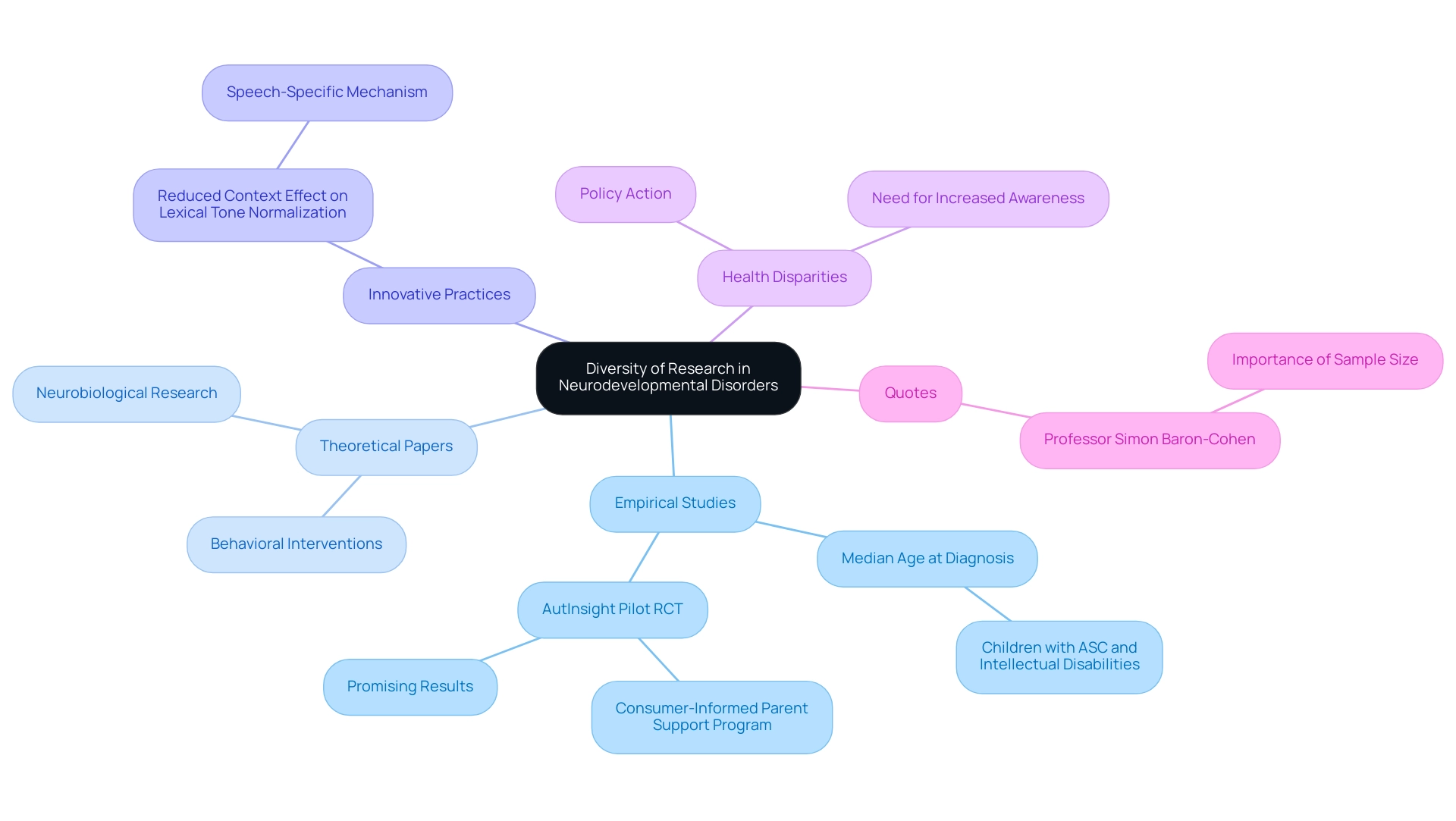
Historical Context: The Evolution of Autism Research Through the Journal
Since its inception, the Journal of Autism and Developmental Disorders has been a beacon of hope, chronicling the evolution of research on developmental disorders. Initially focused on foundational studies, this publication has expanded its horizons to include clinical applications, educational strategies, and policy implications. This shift reflects a profound transformation in our understanding of these conditions, moving from a narrow emphasis on deficits to a broader perspective that recognizes individual strengths and the supports they need.
The journal has been instrumental in documenting significant advancements in this field, including the rise of evidence-based interventions and the acknowledgment of a spectrum of disorders. For instance, a recent study revealed that siblings with developmental disorders share over 50% of their father's genome, challenging previous beliefs about genetic inheritance and opening new avenues for exploration into genetic patterns associated with these conditions. Such findings underscore the journal's commitment to deepening our understanding of the complexities surrounding autism.
Moreover, the Journal of Autism and Developmental Disorders has adeptly adapted to the evolving landscape of developmental studies, reflecting changing emphases over time. As the field progresses, this journal continues to serve as a vital platform for important contributions, ensuring that the latest insights and developments are accessible to both professionals and families. This ongoing documentation not only enriches academic discourse but also empowers the broader community to navigate the challenges and opportunities related to neurodevelopmental disorders.
Considering the financial implications of therapy for those on the spectrum, it is noteworthy that the average cost of therapeutic behavioral services in the U.S. stands at $175.44. This highlights the pressing need for effective studies and interventions. As Sula Wolff aptly stated, "The method that fits them best is the same as that which is suggested for children with Asperger syndrome and high-functioning disorders," emphasizing the importance of tailored strategies in treatment. Additionally, the contributions of individuals engaged in CSHL studies on developmental disorders are invaluable, as they enhance our understanding of genetic factors and their implications for these investigations, further underscoring the impact of the Journal of Autism and Developmental Disorders.
Innovations in Treatment: How the Journal Shapes Intervention Strategies
The journal of autism and developmental disorders serves as a vital resource in advancing our understanding of developmental disorders, sharing innovative treatment strategies that can truly make a difference. By regularly publishing groundbreaking studies on interventions like Applied Behavior Analysis (ABA), cognitive-behavioral therapy, and the integration of emerging technologies, it provides practitioners with critical insights into the latest evidence-based practices and the effectiveness of various interventions.
For example, recent findings reveal that an impressive 99.4% of participants responded positively to questions regarding ASD diagnosis. This statistic underscores the crucial role of accurate assessments in tailoring effective interventions. Additionally, it is important to note that around 28% of children with autism exhibit self-injurious behaviors, highlighting an urgent need for effective therapeutic strategies to mitigate such risks and enhance overall well-being. Ongoing research and increased awareness are essential to address the rising prevalence of ASD and develop effective therapies.
The journal's commitment to innovation shines through its publication of case studies that highlight successful applications of evidence-based practices. A notable example is the case study titled 'Unlocking Emotional Balance: The Transformative Power of Occupational Therapy.' This case study illustrates how occupational therapy can significantly improve emotional regulation in children with developmental disorders. Not only does it enhance the knowledge base of professionals, but it also empowers them to apply the latest discoveries in their practice, ultimately leading to improved outcomes for individuals with developmental disorders.
Moreover, Medicaid plays an essential role in ensuring that children with developmental disorders have access to the care they need to thrive. This further emphasizes the importance of robust support systems for these children. By focusing on the most recent studies and innovative treatment approaches, the journal of autism and developmental disorders acts as a crucial resource for professionals, ensuring they remain knowledgeable and prepared to deliver the highest quality of care in this ever-evolving field of interventions for developmental conditions.
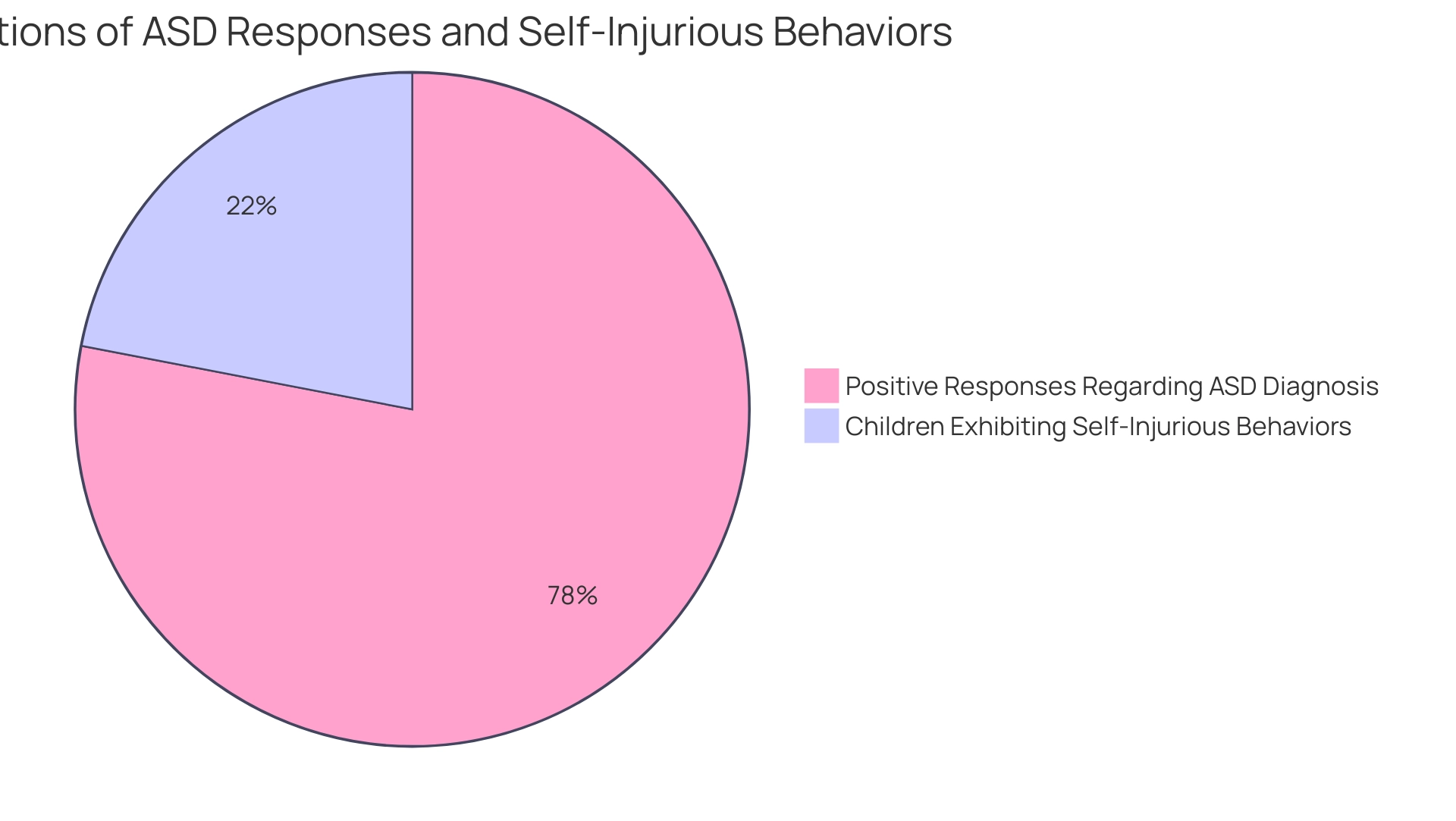
Future Directions: The Journal's Influence on Emerging Research Trends
The landscape of neurological studies is evolving rapidly, with the Journal of Autism and Developmental Disorders playing a pivotal role in shaping new trends. Recent research highlights a growing emphasis on neurodiversity, shedding light on how variations in brain function and behavior contribute to the spectrum of conditions. This shift is essential, as it underscores the strengths and unique perspectives of autistic individuals, moving beyond a focus solely on deficits.
As we look to 2025, there is an increasing examination of the intersection between autism and mental health. Many individuals on the spectrum face co-occurring conditions such as anxiety and depression, making it crucial to understand these complexities for developing comprehensive support strategies. Additionally, the influence of social determinants—like socioeconomic status, access to healthcare, and community support—on outcomes for autistic individuals is gaining attention. This highlights the necessity for holistic approaches to care that consider the whole person.
Importantly, studies reveal that autistic men without learning disabilities have an average life expectancy of 74.6 years, while autistic women average 76.8 years. This statistic emphasizes the need for comprehensive support throughout the lifespan of autistic individuals, ensuring they receive the care they deserve.
The commitment of the Journal of Autism and Developmental Disorders to publishing high-quality research makes it an invaluable resource for both academics and practitioners. By fostering discussions around these emerging topics, the publication enriches academic discourse and informs policy and practice. For example, case studies published in the journal illustrate how task analysis in ABA therapy can effectively teach independence to autistic children by breaking down skills into manageable steps, enhancing their ability to navigate daily challenges.
This method is beautifully exemplified in the case study titled "Task Analysis in ABA: Teaching Independence Through Small, Achievable Steps."
Moreover, insights from leading researchers underscore the significance of these trends. As Jane Miller notes, "Learn about the ABC data sheet, an essential tool in ABA. This guide covers how it helps track behaviors and aids in assessments of professionals in Texas."
As the field continues to advance, the publication's impact will be vital in guiding future research paths, ensuring that the needs of autistic individuals are met with evidence-based interventions and support systems. This ongoing dialogue is crucial for fostering a more inclusive society that recognizes and values neurodiversity. We invite you to share your thoughts and experiences in the comments or through our newsletters, as your voice matters in this important conversation.
Building Community: The Journal's Role in Fostering Collaboration and Support
The Journal of Autism and Developmental Disorders plays a crucial role in nurturing a supportive community among researchers, practitioners, and families touched by developmental disorders. By serving as a platform for sharing research findings, this publication fosters collaboration and dialogue among a diverse array of stakeholders. This community-focused approach aligns beautifully with the mission of organizations like ASD Media, which is committed to empowering individuals through shared knowledge and support.
Importantly, the journal has introduced special editions that highlight community involvement and collaborative studies, underscoring its commitment to building a network that enhances our collective understanding of developmental disorders and promotes effective interventions. For example, a longitudinal study exploring the effects of the COVID-19 pandemic on community participation among autistic adults in Pennsylvania found no significant changes in total participation days or activities. However, it did reveal a concerning reduction in the sufficiency ratio of activities, emphasizing the necessity for tailored planning to assist autistic adults in sustaining their community engagement.
These insights can guide service planning and delivery, ensuring they resonate with the participation interests of autistic adults.
Moreover, statistics show that the odds ratio for having a co-occurring intellectual disability diagnosis in the Low Importance group was 0.54, suggesting a nuanced understanding of the complexities surrounding developmental disorder diagnoses. T.H., a researcher, shared, "All members of the team – especially our Autistic colleagues – perceive this effort to be an authentic co-production." This emphasis on transparency in discussing community engagement and empowering Autistic individuals to lead research initiatives is vital for fostering genuine collaboration in the field.
Through these initiatives, the Journal of Autism and Developmental Disorders not only propels research forward but also strengthens the community devoted to enhancing the lives of individuals with autism.
Conclusion
The Journal of Autism and Developmental Disorders serves as an essential resource in the field of autism research, connecting scientific inquiry with practical application. Its dedication to publishing high-quality, peer-reviewed research on diverse topics—from diagnostic criteria to innovative treatment strategies—ensures that it remains a leader in advancing knowledge. With a notable impact factor and a wide range of contributions, the journal plays a significant role in shaping best practices and guiding policymakers through the complexities of autism spectrum disorders.
As the prevalence of autism continues to grow, the journal’s focus on interdisciplinary collaboration nurtures a community of researchers, clinicians, and educators committed to enhancing outcomes for individuals with autism and their families. By documenting the progression of autism research and emphasizing the importance of social determinants, the journal highlights the need for targeted interventions that tackle health disparities and foster inclusivity.
Looking forward, the Journal of Autism and Developmental Disorders will continue to influence emerging research trends, with a spotlight on neurodiversity, mental health, and comprehensive support strategies. By advocating for innovative methodologies and encouraging collaboration, the journal not only enriches academic dialogue but also empowers practitioners to adopt evidence-based practices that improve the lives of those on the autism spectrum. The ongoing conversations facilitated by the journal are vital in creating a more inclusive society that recognizes and celebrates the unique strengths of individuals with autism.
Frequently Asked Questions
What is the Journal of Autism and Developmental Disorders?
The Journal of Autism and Developmental Disorders is a vital resource dedicated to sharing the latest findings and insights related to autism spectrum disorders (ASD). It publishes peer-reviewed articles on various topics, including diagnostic criteria and intervention strategies, and fosters collaboration among researchers, clinicians, and educators.
What are the current statistics regarding autism prevalence?
Recent statistics indicate a median global prevalence of autism at 65 per 10,000, which marks a significant increase from previous estimates. Prevalence estimates can vary widely, ranging from 1.09 to 436 per 10,000, reflecting the complexity of understanding autism's impact across different populations.
How do social determinants affect autism prevalence?
A review titled 'Social Determinants of Prevalence' highlights that factors such as geography and socioeconomic status can influence access to services and diagnosis. It emphasizes that social determinants interact with biological factors, affecting help-seeking behaviors and access to care, thereby necessitating targeted policies to address health disparities.
What role does the Journal of Autism and Developmental Disorders play in research and treatment?
The journal is committed to publishing high-quality studies that are trustworthy and applicable in real-world situations. Research published in the journal has influenced treatment methodologies and contributed to understanding statistics related to developmental conditions.
What interdisciplinary approaches does the journal encourage?
The Journal of Autism and Developmental Disorders promotes interdisciplinary approaches by inviting contributions from various fields such as psychology, education, and neuroscience, enriching its content and making it a valuable resource for academics, practitioners, and families.
What are some challenges in diagnosing autism?
Diagnosing autism presents complexities, as evidenced by statistics showing significant variations in prevalence based on demographics and identification methods. For instance, in Wisconsin, the prevalence was reported at 28.1 per 1,000 children aged 8 years.
How does the CDC contribute to understanding autism prevalence?
The CDC's Autism and Developmental Disabilities Monitoring Network provides updated prevalence estimates, highlighting the importance of continuous study and data collection in understanding ASD.
What is the ultimate goal of the Journal of Autism and Developmental Disorders?
The journal aims to enhance studies related to developmental conditions and improve outcomes for individuals with ASD and their families by fostering a cooperative atmosphere for research and knowledge sharing.




